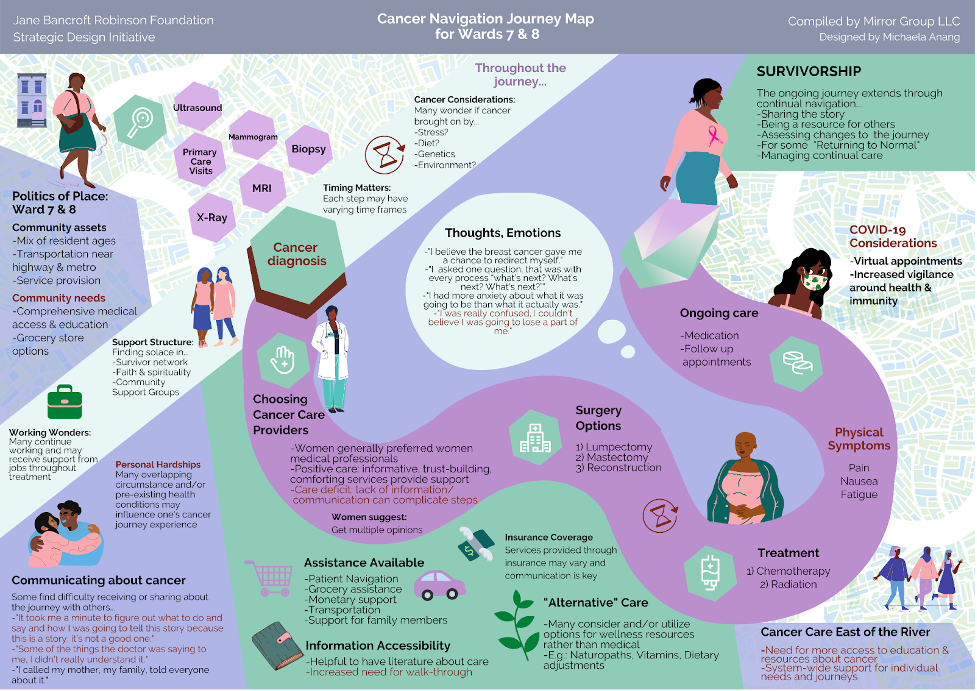
Greetings, I am Marsha Williamson, patient navigation member of Black Women Thriving East of the River (BWTEoR), a five-year breast cancer survivor, and I am a native to Washington, DC and have resided East of the River in Ward 7 for over 20 years. Hello, I am Manon Matchett, Co-Lead, BWTEoR and a 25-year plus resident of the Great Ward 8, located in the southeast quadrant of Washington, DC. Hi, I am Mindelyn Anderson, Founder + Principal of Mirror Group, LLC and LOVER of engaging visuals. We are delighted to share the transformative power of weaving together lived experience narratives into a collective journey.
Sometimes words on the page are not enough. Oftentimes the heart, soul, and depth of navigating inequitable systems, the toll on life and loved ones, and the promise of building equitable futures together can come to life through a visual process. When that is true for you and your social change initiative, we recommend a journey map.
We used a journey mapping process to develop the Cancer Navigation Journey Map, depicted below, to understand how women are navigating care and support.
The women who participated in the cancer navigation journey mapping activity are amazing. Everyone was adamant that they must share their story. It was important that others learned from their respective journeys to ensure optimal care and support. The journey mapping process was extremely important to our initiative! It allowed us to visualize and analyze an individual’s unique experience in their journey from discovery, recovery, and surviving breast cancer. We were able to compare, contrast, and identify the common elements of each person’s journey by seeing common roads, different twists and turns in the roads, and the end roads.

Hot Tips
The interview for the journey map was probably the first time that I verbalized my journey from discovery to recovery. The interview gave me an opportunity to share my thought process of making crucial decisions; such as getting multiple doctor’s opinions; choosing the surgeon that I felt was best for me; deciding between a lumpectomy and mastectomy; and creating a village for the journey. I was asked if my son needed counseling to help him understand and process what was going on; this is something that I had never even thought of, so after the interview I did ask him.
Lessons Learned
A common theme with all the ladies was faith, family, and fight. Despite the diagnosis, all were confident that the prognosis was a long life. Not one person doubted her survivorship, and the amazing fortitude of all the women was inspiring.
Their respective focus was on their loved ones and making sure that everyone else was going to be okay. Different scenarios, but a recurring theme included:
“I told my children after their respective high school and college graduations.”
“I never told my mother or siblings because they already have so much to deal with on their own.”
“I told my Pastor but asked him to keep it private because so many in our congregation were carrying heavy burdens.”
The majority of women did not seek a second opinion. Each believed that their Doctor “knew” best even if the quality of care was not optimal. Many described a very sterile medical engagement that lacked compassion and humanity. It made me sad, mad and proud. These conflicting feelings highlighted the resiliency of these women as a constant state of existence. Yet, they are not dissuaded or discouraged by their circumstance.
The above insights and more informed the design of Black women-centered interventions in cancer navigation and healthcare workforce development in Washington, DC.
The American Evaluation Association is hosting Data Visualization and Reporting (DVR) Week with our colleagues in the DVR Topical Interest Group. The contributions all this week to AEA365 come from DVR TIG members. Do you have questions, concerns, kudos, or content to extend this AEA365 contribution? Please add them in the comments section for this post on the AEA365 webpage so that we may enrich our community of practice. Would you like to submit an AEA365 Tip? Please send a note of interest to AEA365@eval.org. AEA365 is sponsored by the American Evaluation Association and provides a Tip-a-Day by and for evaluators. The views and opinions expressed on the AEA365 blog are solely those of the original authors and other contributors. These views and opinions do not necessarily represent those of the American Evaluation Association, and/or any/all contributors to this site.

Dear Marsha, Manon, and Mindelyn,
I am wiritng to let you know that I think you are all strong women that are inspirational. Also, I think you very much for sharing your stories with everyone. In addition, I appreciate the work you are doing to make lives of those oppressed more equitable. Furthermore, I think that the visual of the Journey maps are amazing.
I am personally a visual person and appreciate how these journey maps come together. I feel like in the case of being a survivor coming together with like people and sharing their journey maps together would be a very emotional time and also a time of healing. I honour you and all of your journeys. My mother was very sick when I was young and I do not remember too much of what she went through, what I do remember is resilience and strength.
I am currently in an Evaluation class for my Masters in Education and as I look at the Journey map I believe that the journey map can be used in many different cases. For myself as a program evaluator I believe that the journey map would be a wonderful way to visualize the program to stakeholders. Also, as a teacher I believe that a journey map will be a great addition to learning and showing outcomes within the classroom. I really love this way of showing experiences to share. Thank you for sharing the journey map with us.
Also, thank you for sharing your stories on your journey, my hope is that it was a healing process, and that sharing together with other women is helpful to them as they begin or finish off their own journeys.
Thank you,
Kristi